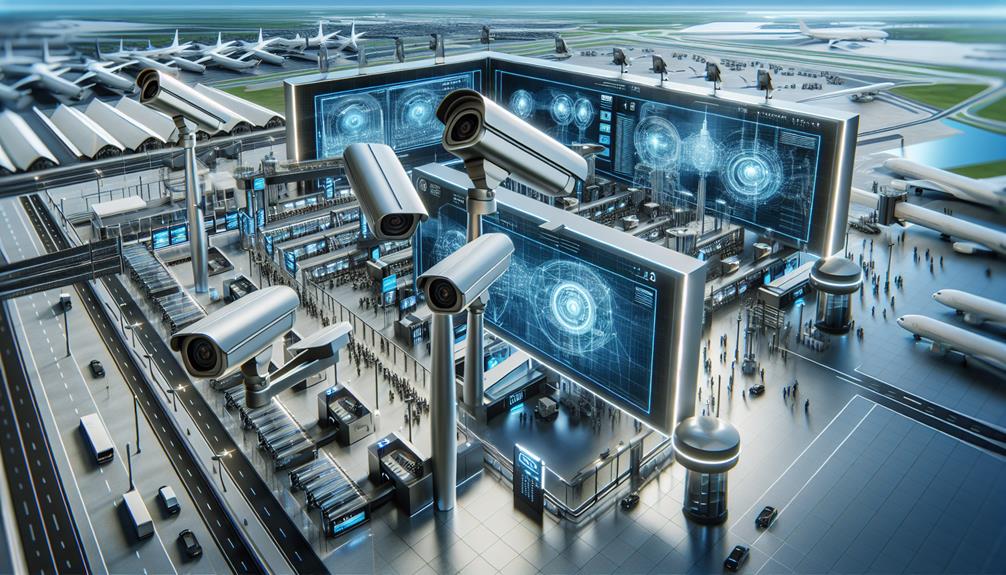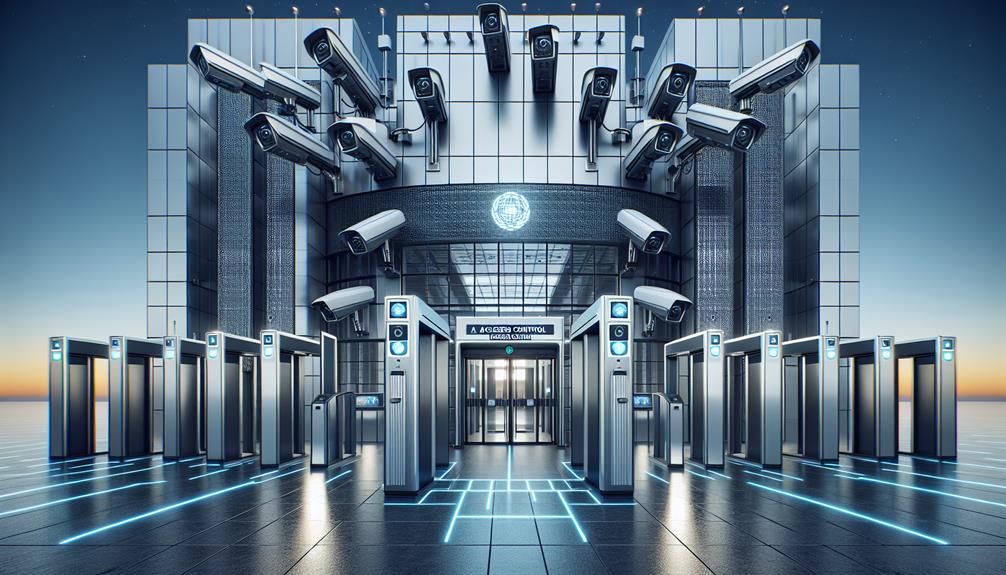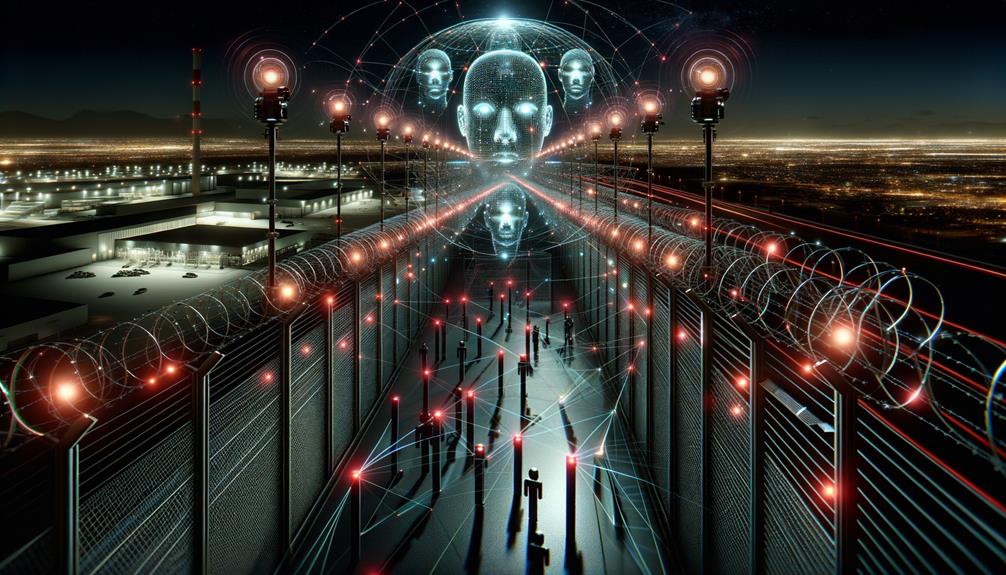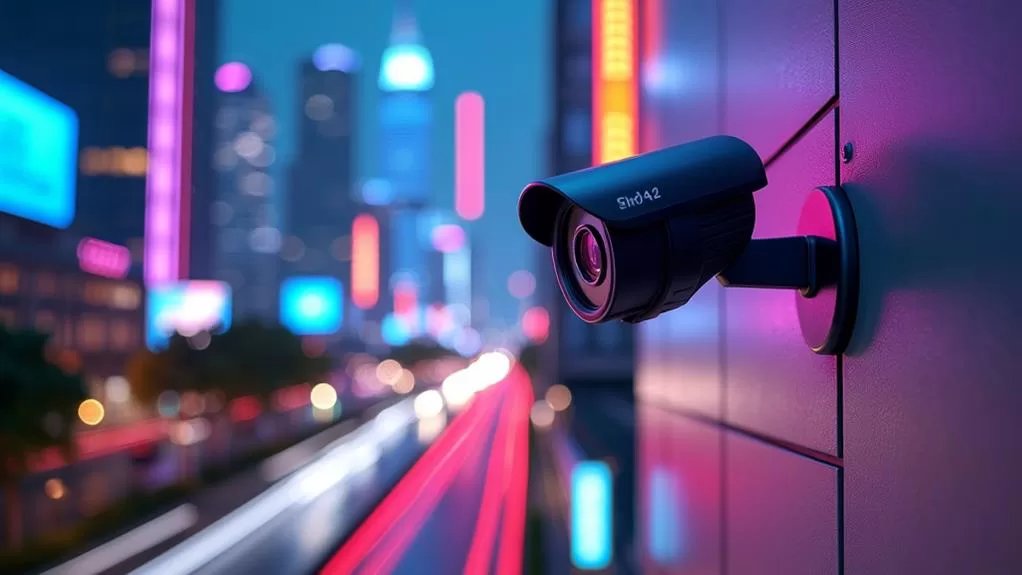I use advanced facial recognition technology to strengthen my perimeter security measures. By integrating facial recognition with surveillance systems, I guarantee seamless and contactless authentication. Specialized cameras equipped with 3D sensors detect and analyze unique facial features, generating a precise faceprint. This information is then matched with stored templates, enhancing access control and preventing unauthorized entry. I can also adjust the system for real-time alerts and efficient crowd management. With continuous AI-powered learning and adaptation, my perimeter security stays strong and ahead of potential threats.
Key Takeaways
- Integration of facial recognition systems into perimeter security enhances contactless authentication and video analytics for real-time threat detection.
- AI-driven facial recognition systems provide accurate identification and reduce unauthorized access risks through advanced algorithms.
- Enhanced access control systems accurately match live facial images with stored templates to prevent unauthorized entry.
- Facial recognition systems learn from new information and adapt to challenging conditions, refining their capabilities over time.
- Integration with existing perimeter security systems strengthens overall security practices and guards against spoilng attempts.
Facial Recognition Fundamentals
Facial recognition technology relies on analyzing unique facial features to create a biometric identification system that seamlessly verifies identities, making it an increasingly popular method for improving security measures. This technology leverages advanced algorithms to capture and analyze specific facial characteristics, generating a mathematical representation known as a 'faceprint.' This faceprint is then compared to the existing database to verify the user's identity.
Facial recognition enhances security by providing a contactless and seamless authentication method. It can integrate with existing systems, including video analytics and access control mechanisms, adding an essential layer of protection. This integration enables multifactor authentication, reducing the likelihood of unauthorized access.
In practice, facial recognition can detect and prevent impersonation fraud by employing advanced liveness tests to distinguish between genuine users and fraudulent attempts. By incorporating facial recognition technology into perimeter security measures, we can greatly strengthen security and ensure a more secure environment.
Surveillance Systems Integration
As we explore the capabilities of facial recognition systems in enhancing perimeter security, it's crucial to discuss the integration of these technologies into surveillance systems.
Smart surveillance systems empowered by facial recognition technology verify identities by mapping the facial identity of the person and providing real-time alerts when pre-defined events occur, such as a block-listed person entering a restricted area or a VIP guest arriving at the reception area.
This integration streamlines identity verification and tracking, ensuring that security personnel can respond promptly to potential threats.
Facial recognition technology accurately identifies individuals, allowing for real-time monitoring and efficient analysis of movement patterns. This proactive approach enables detailed crowd management and evacuation aid during emergencies, greatly reducing risks.
Contemporary Applications

Today, I see facial recognition technology applied extensively, transforming modern security, commerce, and daily life.
The various applications of facial recognition systems are significantly enhancing perimeter security and access control measures. For instance, law enforcement agencies are leveraging facial recognition to identify criminal suspects in real-time, revolutionizing crowd surveillance. Additionally, airport security has been bolstered through the seamless integration of facial recognition with identity verification processes.
Retail stores are also benefiting from this technology by integrating facial recognition with security cameras to prevent shoplifting and fraudulent activities. Missing persons cases are aided by analyzing facial features to locate individuals. Consumer mobile devices utilize facial recognition to authenticate users, eliminating the need for passwords and enhancing device security.
Facial recognition technology has become an indispensable tool for a wide range of applications, offering an unprecedented level of security, convenience, and efficiency.
Law Enforcement Case Studies
To illustrate the impactful role facial recognition plays in bolstering law enforcement, let's examine several high-profile case studies where this technology has successfully enhanced investigation and security processes.
One notable example is the ACLU v. DOJ, FBI & DEA case, where the ACLU aimed to uncover information about the use of facial recognition technology by the Department of Justice, FBI, and DEA, highlighting the potential for its use in ensuring the accuracy of criminal investigations.
Additionally, the case of Nijeer Parks, where an unjust arrest was made due to an incorrect match from facial recognition technology, underscores the importance of ensuring the reliability of these systems.
Moreover, the Williams v. City of Detroit case, settled in January 2024, emphasized the need for law enforcement to be accountable for their reliance on this technology to prevent wrongful arrests.
These instances demonstrate how facial recognition systems can either aid or hinder law enforcement efforts, emphasizing the necessity for robust security measures and careful analysis to prevent misidentification.
The ACLU v. Clearview AI lawsuit, settled in May 2022, focused on privacy rights violations in Illinois, highlighting the importance of ethical implementation. Proper use of facial recognition technology is pivotal in maintaining the integrity of law enforcement proceedings.
Integration With Access Control

When enhancing security measures, perimeter security systems can be upgraded with facial recognition integration to enable swift, secure, and contactless authentication for authorized individuals. This seamless integration enhances the efforts of access control systems, making sure that only authorized personnel gain entry.
The facial recognition software leverages the unique features of each individual's face, making it an ideal biometric credential. It's a technology that guards against potential threats by accurately matching live facial images with stored templates, excluding unauthorized access.
This thorough authentication process reduces security risks by eliminating the need to physically interact with devices or carry identification cards. Moreover, it operates at incredible speeds, providing real-time identification results, making it particularly valuable in high-traffic areas where quick and efficient access control is necessary.
The amalgamation of facial recognition with existing infrastructure ensures that modern access control systems become robust and resistant to spoofing attempts. Essentially, such technology strengthens perimeter security by providing a technological shield against potential threats, making it a central component of modern security best practices.
Future Developments and Challenges
When it comes to future developments in facial recognition systems, I believe that enhanced accuracy through AI algorithms and deep learning techniques will be essential in improving overall performance.
Another significant challenge in this technology lies in addressing privacy concerns, ensuring data security, and reducing error rates.
Incorrect Retention
Incorrect Retention
One primary concern in the implementation of facial recognition systems is ensuring the secure and responsible retention of collected biometric data. Incorrect retention can lead to significant privacy risks, as unauthorized access or misuse of this data can result in data breaches and identity theft. Minimizing retention periods is essential, but ensuring compliance with data protection regulations is equally important. This delicate balance must be maintained through proper data handling practices.
Retention Challenges
| Challenge | Description |
|---|---|
| Data Protection Regulations | Ensuring compliance with regulations while balancing data needs. |
| Data Breaches | Protecting against unauthorized access to sensitive data. |
| Retention Periods | Minimizing retention to reduce potential risks. |
| Identity Theft | Preventing misuse of biometric data. |
| Compliance | Maintaining adherence to established data protection rules.
AI Integration
With the integration of advanced artificial intelligence (AI) into facial recognition systems, the accuracy and efficiency of these technologies are poised to take a significant leap forward.
AI integration has the potential to enhance the speed and precision with which facial recognition systems identify individuals. By leveraging AI algorithms, these systems can analyze vast amounts of data and quickly match faces against databases, improving overall performance.
Furthermore, AI-powered facial recognition systems can adapt and learn from new information, continuously refining their capabilities over time. This dynamic learning process enables the technology to evolve and become more adept at recognizing faces accurately, even in challenging conditions.
Frequently Asked Questions
How Does Facial Recognition Strengthen Security Measures?
As I implement facial recognition, I enhance security with precise biometric identification, swift real-time authentication, and seamless integration with access control systems.
What Are the Best Practices for Network Perimeter Security?
'To strengthen network perimeter security, I guarantee strong firewall configurations, implement intrusion detection and prevention systems, and enforce strict access control, regularly updating and evaluating these measures for best protection.'
What Are the Guidelines for Implementing an Effective Security Perimeter?
To implement an effective security perimeter, I establish clear boundaries and entry points using barriers and access control, then integrate surveillance monitoring and regularly assess security protocols to adapt to evolving threats.
What Is Perimeter Security in Cyber Security?
"As a cybersecurity expert, I define perimeter security as the critical layer of defense protecting a network from unauthorized access and cyber threats. Its importance lies in preventing breaches, implementing measures like firewalls and intrusion detection systems, and maintaining continuous monitoring and updates."










1 comment
Comments are closed.